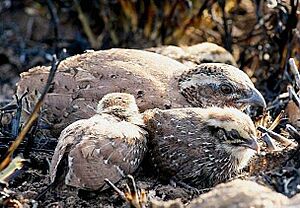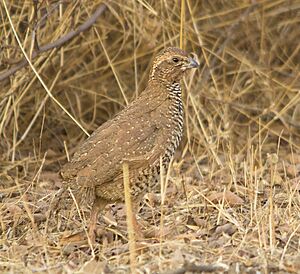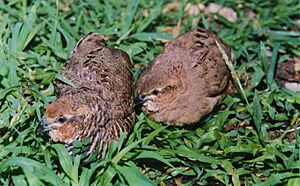Rock bush quail facts for kids
Quick facts for kids Rock bush quail |
|
|---|---|
 |
|
| A male (Rajasthan) | |
 |
|
| Family | |
| Conservation status | |
| Scientific classification |
The rock bush quail (Perdicula argoondah) is a type of quail bird. You can find it in certain parts of India. This bird is quite common and lives across a large area. Because of this, experts say it is a "least concern" species. This means it is not currently in danger of disappearing.
Contents
What is the Rock Bush Quail?
The rock bush quail looks a lot like another bird called the jungle bush quail. Both birds live in the same areas. These quails usually live in small groups called coveys. You might not notice them until they suddenly fly out from under plants.
How Big Are They?
This bird is about 17 to 18.5 centimeters long. It weighs about 64 to 85 grams. It has brown feathers with darker stripes and spots.
Special Features
One special thing about the rock bush quail is its outermost primary feather. This feather is longer than the one closest to its body. Also, the inner part of its primary feathers has stripes or speckles. Its call starts as a trill, then changes to a series of soft piping sounds. These sounds get louder as the bird continues to call.
Where Do Rock Bush Quails Live?
The rock bush quail lives in the western half of India. It does not move to other places during different seasons. It prefers dry areas with grassy fields and thorny bushes. You usually won't find this bird living higher than about 600 meters above sea level.
What is the Rock Bush Quail's Status?
The rock bush quail lives in a very large area. It is common in many of these places. The International Union for Conservation of Nature (IUCN) checks on animals and plants. They have listed the rock bush quail as a "least concern" species.
Even though it's common, the number of these birds might be slowly going down. This is because people sometimes hunt them. Also, their homes are sometimes destroyed. However, the number of birds is not dropping fast enough to make them a more threatened species right now.
Images for kids







